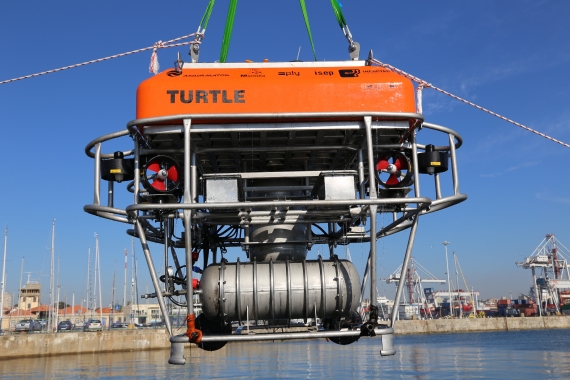Activities
TURTLE
Autonomous robotic deep sea lander
Description
TURTLE is an
autonomous robotic deep sea lander, which has been developed by INESC TEC, the Autonomous Systems Laboratory (LSA)
of the School of Engineering of the Polytechnic Institute of Porto (ISEP), the Portuguese
Navy Research Centre (CINAV), and the companies ply and A. Silva Matos
Metalomecânica (the latter was the leader of the consortium). It is operating since 2015.
TURTLE is a hybrid
lander, being capable of staying at the bottom of the sea for long periods of
time, but also of autonomously relocating itself and surfacing for maintenance
operations. It is also able to dive and ascend with high-energy
efficiency, and its autonomous capabilities allow for reduced operational costs
and flexibility.
TURTLE is the first deep sea robotic system
fully developed at Portugal.
Specifications
General
- Vehicle type: autonomous robotic deep sea lander
- Body materials: metal sandwich panels, syntatic foam, stainless steel
- Deployment: four hooks for craning, and capability to be towed
- Length: 1.9 m
- Width: 1.6 m
- Height: 2 m
- Weight in air: 1350 kg
- Power: rechargeable batteries (LiFePO4, 8 kWh, extensible)
- Battery charge time: 6 h
- Payload capacity: 200 kg
- Payload interfaces/ports: ethernet, serial RS232/485, with underwater connectors
Operation
- Maximum depth: 1000 m
- Autonomy: 1 month
- Relocation range: 500 m (without resurfacing)
- Propulsion: variable buoyancy system (VBS), four horizontal and four vertical thrusters (all independent)
- Degrees of freedom: 6DOF
- Communications: underwater acoustic communications; Wi-Fi/RF/GSM and satellite communications at the surface
- Navigation systems: DVL, IMU, USBL, mapping sonars, UW vision, GPS (pop-up and surface nav)
- Modes of operation: transportation to or from the ocean floor, multiple ascend/descend movements and seafloor re-positioning
Sensors
- USBL
- DVL
- INS/GPS
- Multibeam
- Pressure sensors
- Altimeter
- Video camera + lasers
- SLS system
- Seismometer
- Acoustic pinger
- Hydrophone to gather ocean sound data or launch alerts
- Additional payload capability
Features
- Hybrid lander combining mobility with long-term presence in the deep sea
- Autonomous positioning
- Hovering capability without disturbing sea floor and water turbidity
- Energy efficient technologies for ascent-descent operations
- Untethered system (no cables sent to the surface)
- Modular, light and pressure resistant mechanical structures
- On-board processing and sensor data logging
- Robotic technologies, enabling reduced maintenance and operational requirements
- Increases human presence and observation capabilities in the deep sea
Applications
General
- Transportation and deployment of materials and tools to the seabed
- Communications and navigation support for underwater systems
Civilian
- Ocean observatories
- Marine biology monitoring
- Oceanography
- Seismic and acoustic activity monitoring
Military
- Harbour protection
- Border monitoring
- Intruder detection and monitoring
Flyer
Download filePhotos and
videos are available at the Gallery.
